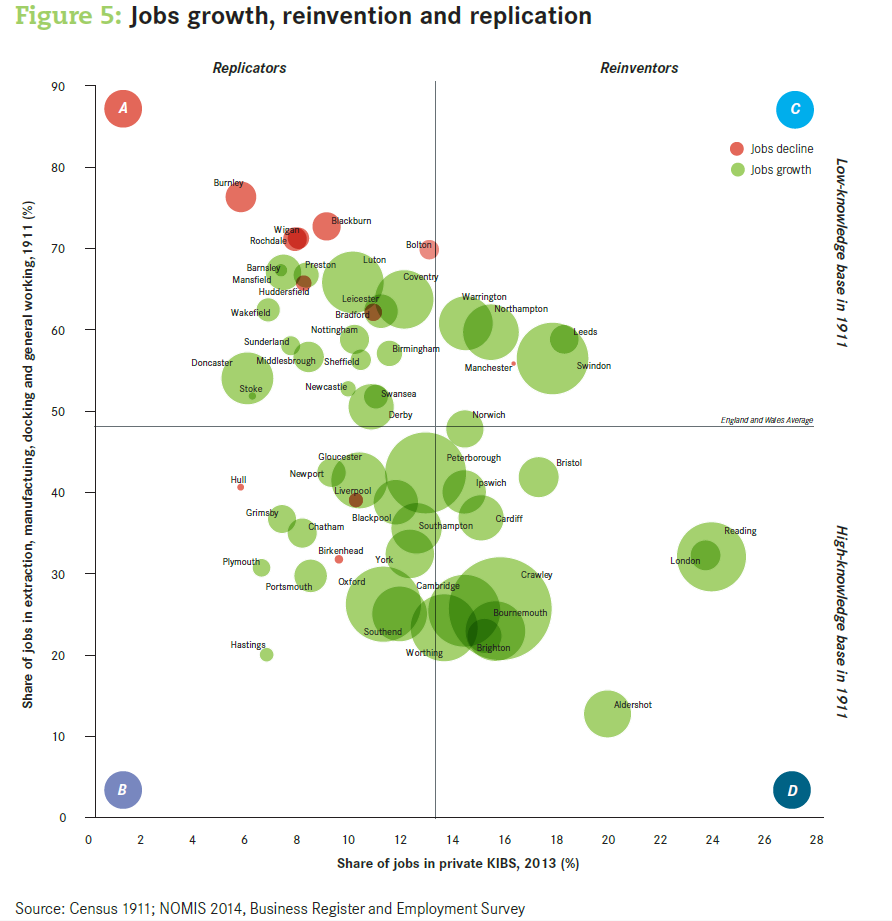 Posted Mar 13, 2015, 4:36 PM
Posted Mar 13, 2015, 4:36 PM
|
 |
Registered User
|
|
Join Date: Aug 2002
Location: Toronto
Posts: 52,200
|
|
|
An intriguing new report looks at long-term economic trends in metros across Britain.
Why Some U.K. Cities Thrive While Others Decline
Mar 12, 2015
By RICHARD FLORIDA
Read More: http://www.citylab.com/work/2015/03/...ecline/387562/
PDF Report: http://www.centreforcities.org/wp-co...-of-Cities.pdf
Quote:
.....
British cities’ performances in this new economy is decidedly mixed, the report finds. The once-powerful manufacturing metros of the North, Midlands and Wales have fallen further and further behind, while those in the South have adapted, achieving much higher rates of growth. As the report notes, every job created in the less successful regions since 1911 has equaled 2.3 jobs in the more prosperous South.
- The report’s authors classify cities and metro areas into two broad categories: “reinventors” and “replicators.” --- Reinventors are described as being like mini-versions of the ever-adapting Silicon Valley, with the ability to incubate and take on whole new fields of technology. These metros have shifted their economies to knowledge industries like information technology, biotech and digital media. --- Replicators, by contrast, are defined as having remained tied into their once-powerful manufacturing economies by investing in low-skill, more routinized industries, and have been far less able to shift their economies into the knowledge age.
- The report highlights the central role played by talent, human capital and skills. The knowledge economy is powered not just by the clustering of firms per se, but by the clustering of talented, highly-skilled workers. This is key to business location and development. Businesses make location decisions less based on labor costs and more on “the ease with which they can recruit [high-skill] workers,” as the report points out. Cities, then, should step up their education efforts, from jobs training programs to elementary schools to secondary education.
- The post-industrial economy revolves around networks between and connections across companies, a sharp contrast to the large, vertically integrated industries of the industrial age. Cities, the report notes, need to be able to foster innovation by creating knowledge networks that will increase their productivity in the long run.
- Success in the knowledge economy is increasingly place-bound, a function of density and the close clustering and mixing of talent and businesses. The footprint of the knowledge economy is much more compact than its manufacturing predecessor, requiring less space and leaving large swaths of land—once filled with factories—completely empty. At the same time, large factory and warehouse buildings are favored by knowledge workers and knowledge industries. But cities must reuse them in ways that achieve clustering and density, especially when they are located in or around the urban core.
.....
|
An office building goes up in Reading, a British city that has seen great growth in knowledge economy jobs since 1911. (Flickr/Tristram Brelstaff)
 The map below shows this divided geographic pattern of economic growth. The metros with the largest and greenest circles—which indicate the most positive job growth—are concentrated below the mid-island city of Peterborough. The red circles shows metros in decline.
The map below shows this divided geographic pattern of economic growth. The metros with the largest and greenest circles—which indicate the most positive job growth—are concentrated below the mid-island city of Peterborough. The red circles shows metros in decline.
 The matrix below, from the report, charts the job growth success of British cities along a two metrics. The X-axis arrays cities by the share of jobs in knowledge-intensive business services (or KIBS) as of 2013. The Y-axis arrays them by the share of jobs in manufacturing, construction, extraction and related fields back in 1911.
The matrix below, from the report, charts the job growth success of British cities along a two metrics. The X-axis arrays cities by the share of jobs in knowledge-intensive business services (or KIBS) as of 2013. The Y-axis arrays them by the share of jobs in manufacturing, construction, extraction and related fields back in 1911.
 As the chart below shows, cities in quadrants C and especially D have been most successful, with higher wages, higher productivity (measured by gross value added per worker), more new business startups, and higher levels of human capital. Cities in quadrants A and B, by contrast, have more workers with low qualifications and higher shares of working age residents who are dependent on the U.K.’s welfare program benefit (DWP).
As the chart below shows, cities in quadrants C and especially D have been most successful, with higher wages, higher productivity (measured by gross value added per worker), more new business startups, and higher levels of human capital. Cities in quadrants A and B, by contrast, have more workers with low qualifications and higher shares of working age residents who are dependent on the U.K.’s welfare program benefit (DWP).

__________________
ASDFGHJK
|



